BT8P Module Datasheet
Last Updated on : 2024-11-20 08:22:20download
BT8P is a low-power embedded Bluetooth module that Tuya has developed. It consists of a highly integrated Bluetooth chip (TLSR8250F512ET32), a few peripheral circuits, an embedded Bluetooth network communication protocol stack, and varied library functions.
After a period of service, this module will become deprecated due to product upgrades and iterations, user requirements, production inventory, or other reasons. To improve the compatibility of your smart devices and minimize the impact on your use, Tuya continues to provide webpage documentation of deprecated modules, but no longer maintains or updates the documentation. The content herein is for reference only.
If you have any questions, submit a ticket to contact Tuya or consult Tuya’s account manager to request support. If you need similar substitute products, see BTU Module Datasheet.
Overview
BT8P further contains a low-power 32-bit MCU, a Bluetooth 5.0/2.4-G Radio, a 512-KB flash memory, a 48-KB static random-access memory (SRAM), and 6 reusable I/O ports.
Features
- Embedded low-power 32-bit MCU, which can also function as an application processor
- The clock rate: 48 MHz
- Working voltage: 1.8 to 3.6 V. If the voltage is between 1.8 and 2.7 V, the module can start, but the RF performance cannot be ensured. If the voltage is between 2.8 and 3.6 V, the overall performance of the module is normal.
- Peripherals: 5 pulse width modulations (PWM), an analog-to-digital converter (ADC), and a universal asynchronous receiver/transmitter (UART)
- Bluetooth RF features
- Compatible with Bluetooth 5.0
- RF data rate: 1 Mbps, 2 Mbps
- TX power: +10 dBm
- RX sensitivity: -94.5 dBm@Bluetooth 1 Mbps
- Embedded hardware AES encryption
- Onboard PCB antenna with a gain of 2.5 dBi
- Working temperature: -40 to +85℃
Applications
- Smart LED
- Smart home
- Smart low-power sensor
Module interfaces
Dimensions and footprint
BT8P has a row of pins with a 1.27 mm pin spacing.
The BT8P dimensions are 16±0.35 mm (W)×24.8±0.35 mm (L) ×3.5±0.15 mm (H). The thickness of the PCB is 1.2±0.1 mm. The layout is shown below:

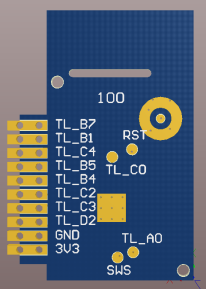
Pin definition
| Serial number | Symbol | I/O type | Function |
|---|---|---|---|
| 1 | 3V3 | P | Power supply pin (3.3V) |
| 2 | GND | P | Power supply reference ground |
| 3 | TL_D2 | I/O | A common I/O interface, which can be PWM output to drive LED and corresponds to TL_D2 of IC |
| 4 | TL_C3 | I/O | A common I/O interface, which can be PWM output to drive LED and corresponds to TL_C3 of IC |
| 5 | TL_C2 | I/O | A common I/O interface, which can be PWM output to drive LED and corresponds to TL_C2 of IC |
| 6 | TL_B4 | I/O | A common I/O interface, which can be PWM output to drive LED and corresponds to TL_B4 of IC |
| 7 | TL_B5 | I/O | A common I/O interface, which can be PWM output to drive LED and corresponds to TL_B5 of IC |
| 8 | TL_C4 | I | ADC, which corresponds to TL_C4 of IC |
| 9 | TL_B1 | I/O | Serial interface transmit pin UART TX, which corresponds to TL_B1 of IC |
| 10 | TL_B7 | I/O | Serial interface receive pin UART RX, which corresponds to TL_B7 of IC |
Note:
- P indicates power supply pins and I/O indicates input/output pins.
- If you have specific requirements on the light color controlled by PWM output, please contact the business personnel of Tuya.
Electrical parameters
Absolute electrical parameters
| Parameter | Description | Minimum Value | Maximum Value | Unit |
|---|---|---|---|---|
| Ts | Storage temperature | -65 | 150 | ℃ |
| VCC | Power supply voltage | -0.3 | 3.9 | V |
| Static electricity discharge voltage (human body model) | TAMB-25℃ | - | 2 | KV |
| Static electricity discharge voltage (machine model) | TAMB-25℃ | - | 0.5 | KV |
Working conditions
| Parameter | Description | Minimum Value | Typical Value | Maximum Value | Unit |
|---|---|---|---|---|---|
| Ta | Working temperature | -40 | - | 85 | ℃ |
| VCC | Working voltage | 1.8 | 3.3 | 3.6 | V |
| VIL | IO low level input | VSS | - | VCC*0.3 | V |
| VIH | IO high level input | VCC*0.7 | - | VCC | V |
| VOL | IO low level output | VSS | - | VCC*0.1 | V |
| VOH | IO high level output | VCC*0.9 | - | VCC | V |
Power consumption in working mode
| Symbol | Conditions | Typical Value | Unit |
|---|---|---|---|
| Itx | Constantly transmit, output power of 10.5 dBm | 20 | mA |
| Irx | Constantly receive | 6.3 | mA |
| IDC | The networking state | 7.4 | mA |
| Ideepsleep1 | Deep sleep mode (reserve16 KB RAM) | 1.2 | μA |
| Ideepsleep2 | Deep sleep mode (not reserve RAM) | 0.4 | μA |
RF parameters
Basic RF features
| Parameter | Description |
|---|---|
| Working frequency | 2.4 GHz ISM band |
| Wireless standard | Bluetooth 5.0 |
| Data transmission rate | 1 Mbps, 2 Mbps |
| Antenna type | Onboard PCB antenna |
RF output power
| Parameter | Minimum Value | Typical Value | Maximum Value | Unit |
|---|---|---|---|---|
| Average RF output power | -22 | 10 | 10.5 | dBm |
| 20 dB modulation signal bandwidth (1 Mbps) | - | 2500 | - | KHz |
| 20 dB modulation signal bandwidth (2 Mbps) | - | 2600 | - | KHz |
RF receiving sensitivity
| Parameter | Minimum Value | Typical Value | Maximum Value | Unit |
|---|---|---|---|---|
| RX sensitivity 1 Mbps | - | -94.5 | - | dBm |
| RX sensitivity 2 Mbps | - | -90 | - | dBm |
| Frequency offset error (1 Mbps) | -300 | - | +300 | KHz |
| Frequency offset error (2 Mbps) | -200 | - | +200 | KHz |
| Co-channel interference suppression | - | -7 | - | dB |
Antenna information
Antenna type
BT8P uses an onboard PCB antenna.
Antenna interference reduction
To ensure RF performance, it is recommended that the antenna be at least 15 mm away from other metal parts.
To ensure the antenna performance, the PCB should not be routed or clad with copper in the antenna area. The main points of the layout:
- Make sure there is no substrate medium directly below or above the printed antenna.
- Make sure that the area around the printed antenna is far away from copper, so as to ensure the radiation effect of the antenna to the greatest extent.
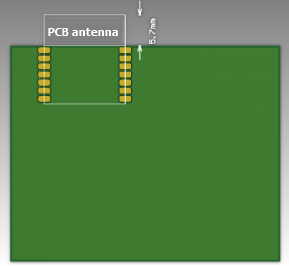
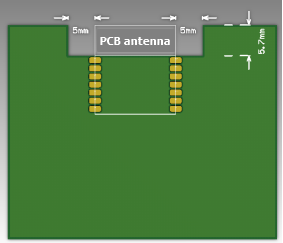
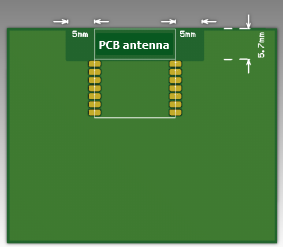
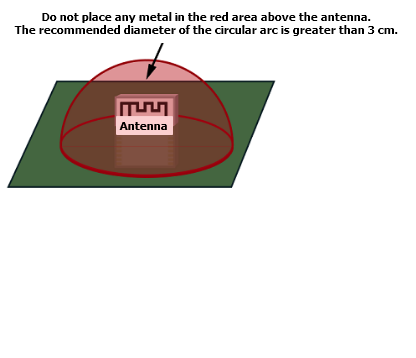
Packaging information and production instructions
When designing the finished product, please leave enough space for the antenna area.
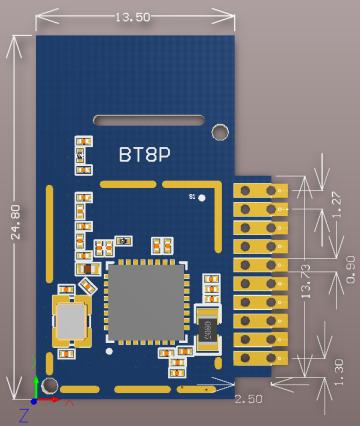
Note: The default outline dimension tolerance is ±0.35 mm, and the critical dimension tolerance is ±0.1 mm. If you have specific requirements on dimensions, make them clear in the datasheet after communication.
Production instructions
-
For the in-line module developed by Tuya, wave soldering equipment is most preferred and manual soldering is less preferred. After being unpacked, the module must be soldered within 24 hours. Otherwise, it must be put into the drying cupboard where the RH is not greater than 10%, or it needs to be packaged under vacuum again and record the exposure time (the total exposure time cannot exceed 168 hours).
-
Soldering equipment and materials:
- Wave soldering equipment
- Wave soldering fixture
- Constant-temperature soldering iron
- Tin bar, tin wire, and flux
- Oven temperature tester
-
Baking equipment:
- Cabinet oven
- Anti-static heat-resistant pallets
- Anti-static heat-resistant gloves
-
The module needs to be baked in the following cases:
- The vacuum packing bag was found to be damaged before being unpacked.
- There is no humidity indicator card (HIC) in the vacuum packing bag.
- After being unpacked, 10% and above circles on the HIC become pink.
- The total exposure time has been more than 168 hours since unpacking.
- More than 12 months have passed since the sealing date of the bag.
-
Baking settings:
-
Temperature: 60°C and ≤ 5%RH for reelizing and 125°C and ≤5%RH for palletizing (please use a heat-resistant pallet rather than a plastic pallet)
-
Time: 48 hours for reelizing and 12 hours for palletizing
-
Alarm temperature: 65°C for reelizing and 135°C for palletizing
-
Production ready temperature after natural cooling: < 36°C
-
The number of drying times: 1
-
Re-baking requirement: If a module remains unused for 168 hours after being unpacked, it must be baked again.
Important: If this batch of modules is not baked within 168 hours, do not use wave soldering to solder them. Because the modules are 3-level moisture-sensitive components, they are very likely to get damp when exposed outside. In this case, if they are soldered at high temperatures, it may result in component failure or poor soldering.
-
-
In the whole production process, take electrostatic discharge (ESD) protective measures.
-
To guarantee the quality of products, you must pay attention to the following items:
- The amount of soldering flux.
- The height of the wave peak.
- Whether the tin slag and copper content in the wave soldering tank exceed standards.
- Whether the window and thickness of the wave soldering fixture are appropriate.
- Whether the wave soldering oven temperature curve is reasonable.
Recommended oven temperature curve and temperature
For oven temperature setting, refer to oven temperatures for wave soldering. The peak temperature is 260°C±5°C. The wave soldering temperature curve is shown below:
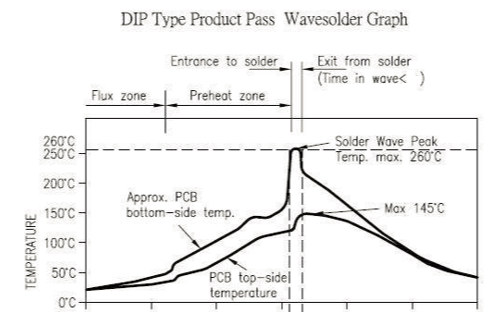
Recommended soldering temperature:
| Recommended wave soldering oven temperature | Recommended manual soldering temperature | ||
|---|---|---|---|
| Preheat temperature | 80 to 130 °C | Soldering temperature | 360±20°C |
| Preheat time | 75 to 100s | Soldering time | <3s/point |
| Peak contact time | 3 to 5s | NA | NA |
| Temperature of tin cylinder | 260±5°C | NA | NA |
| Ramp-up slope | ≤2°C/s | NA | NA |
| Ramp-down slope | ≤6°C/s | NA | NA |
Storage conditions
Storage conditions for a delivered module are as follows:
-
The moisture-proof bag is placed in an environment where the temperature is below 40°C and the relative humidity is lower than 90%.
-
The shelf life of a dry-packaged product is 12 months from the date when the product is packaged and sealed.
-
The package contains a humidity indicator card (HIC).
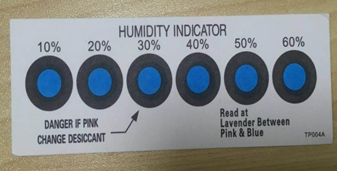
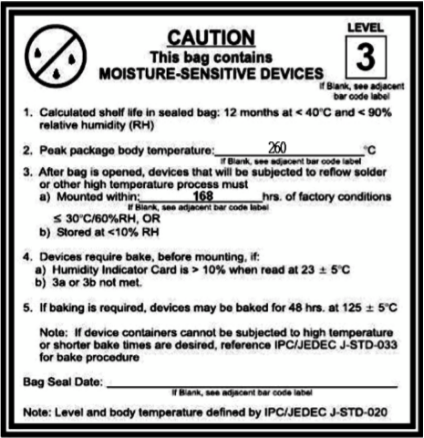
MOQ and packaging information
| Product number | MOQ (pcs) | Shipping packaging method | The number of modules per reel | The number of reels per carton |
|---|---|---|---|---|
| BT8P | 4400 | Tape reel | 1100 | 4 |
Appendix: Statement
FCC Caution: Any changes or modifications not expressly approved by the party responsible for compliance could void the user’s authority to operate this device.
This device complies with Part 15 of the FCC Rules. Operation is subject to the following two conditions: (1) This device may not cause harmful interference, and (2) this device must accept any interference received, including interference that may cause undesired operation.
Note: This device has been tested and found to comply with the limits for a Class B digital device, according to part 15 of the FCC Rules. These limits are designed to provide reasonable protection against harmful interference in a residential installation. This device generates, uses, and can radiate radio frequency energy and, if not installed and used following the instructions, may cause harmful interference to radio communications. However, there is no guarantee that interference will not occur in a particular installation.
If this device does cause harmful interference to radio or television reception, which can be determined by turning the device off and on, the user is encouraged to try to correct the interference by one or more of the following measures:
- Reorient or relocate the receiving antenna.
- Increase the separation between the device and receiver.
- Connect the device to an outlet on a circuit different from that to which the receiver is connected.
- Consult the dealer or an experienced radio/TV technician for help.
Radiation Exposure Statement
This device complies with FCC radiation exposure limits set forth for an uncontrolled rolled environment. This device should be installed and operated with a minimum distance of 20cm between the radiator and your body.
Important Note
This radio module must not be installed to co-locate and operate simultaneously with other radios in the host system except following FCC multi-transmitter product procedures. Additional testing and device authorization may be required to operate simultaneously with other radios.
The availability of some specific channels and/or operational frequency bands are country dependent and are firmware programmed at the factory to match the intended destination. The firmware setting is not accessible by the end-user.
The host product manufacturer is responsible for compliance with any other FCC rules that apply to the host not covered by the modular transmitter grant of certification. The final host product still requires Part 15 Subpart B compliance testing with the modular transmitter installed.
The end-user manual shall include all required regulatory information/warnings as shown in this manual, including “This product must be installed and operated with a minimum distance of 20 cm between the radiator and user body”.
This device has got an FCC ID: 2ANDL-BT8P. The end product must be labeled in a visible area with the following: “Contains Transmitter Module FCC ID: 2ANDL-BT8P”.
This device is intended only for OEM integrators under the following conditions:
The antenna must be installed such that 20cm is maintained between the antenna and users, and the transmitter module may not be co-located with any other transmitter or antenna.
As long as the 2 conditions above are met, further transmitter tests will not be required. However, the OEM integrator is still responsible for testing their end-product for any additional compliance requirements required with this module installed.
Declaration of Conformity European Notice

Hereby, Hangzhou Tuya Information Technology Co., Ltd declares that this module product is in compliance with essential requirements and other relevant provisions of Directive 2014/53/EU,2011/65/EU. A copy of the Declaration of conformity can be found at https://www.tuya.com.

This product must not be disposed of as normal household waste, in accordance with the EU directive for waste electrical and electronic equipment (WEEE-2012/19/EU). Instead, it should be disposed of by returning it to the point of sale, or to a municipal recycling collection point.
The device could be used with a separation distance of 20cm from the human body.
Is this page helpful?
YesFeedbackIs this page helpful?
YesFeedback





